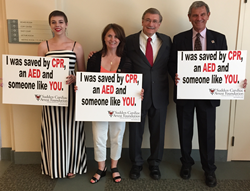Sudden Cardiac Arrest Foundation Applauds Institute of Medicine Report on Cardiac Arrest


Pittsburgh, PA (PRWEB)
July 02, 2015
The Sudden Cardiac Arrest Foundation applauds the Institute of Medicine report, “Strategies to Improve Cardiac Arrest Survival: A Time to Act,” released this week in Washington, D.C. The report suggests the U.S. is falling short in efforts to improve outcomes from cardiac arrest and offers strategies to increase survival rates.
“The Institute of Medicine report on cardiac arrest, ‘A Time to Act,’ is a landmark study that has the potential to positively impact survival and post-survival quality of life,” said Mary Newman, Sudden Cardiac Arrest Foundation president. “We are especially pleased that the IOM recommends all students should learn CPR and how to use automated external defibrillators (AEDs) before high school graduation.”
Unlike many other medical conditions, cardiac arrest requires immediate help from the community. When bystanders recognize the emergency and act quickly by calling 9-1-1, starting CPR, and using the nearest AED, the chances of survival increase dramatically. “Our growing community of survivors is a testament to the power of swift community action,” said Newman. “Our vision is to see the day when survival from cardiac arrest becomes the norm, rather than the exception. Activating our communities is a key to realizing that vision.”
Cardiac arrest, the cessation of the electrical and mechanical activity of the heart, is the third leading cause of death in the United States, following cancer and heart disease, according to the IOM. It strikes about 395,000 people outside hospitals every year and on average, less than 6 percent of victims survive. Yet some high-performing communities in the U.S. have reported survival rates of more than 60 percent for specific types of cardiac arrest, which indicates that saving more lives is possible.
Despite its large public health footprint, cardiac arrest does not resonate with the public and policy makers the same way as other conditions such as stroke, cancer, and HIV, according to committee member Lance Becker, MD, of the University of Pennsylvania. “The most significant finding of this study is that some communities are doing very well in treating cardiac arrest, but the average American does not live in one of those communities.”
The IOM committee recommends that the following actions should be undertaken by several stakeholder groups, namely the public, EMS response organizations, health care organizations, researchers, and policy/advocacy/political groups:
1. Establish a national registry of cardiac arrest to monitor performance, identify problems, and track progress
2. Educate and train the public on how to recognize cardiac arrest, contact emergency responders, administer CPR, and use AEDs
3. Facilitate state and local education departments to include CPR and AED training as secondary school graduation requirements
4. Enhance performance of EMS systems with emphasis on dispatcher-assisted CPR and high-performance CPR
5. Develop strategies to improve systems of care within hospital settings
6. Adopt continuous quality improvement programs for cardiac arrest
7. Expand research in cardiac arrest resuscitation and promote innovative technologies and treatments
8. Create a national cardiac arrest collaborative to unify the field and identify common goals.
“It is exciting to know that our efforts to raise awareness and save lives align with the Institute of Medicine recommendations,” said David Belkin, a cardiac arrest survivor and member of the Sudden Cardiac Arrest Foundation board of directors. The Foundation works to educate the public and media about the difference between heart attack and cardiac arrest, to advocate for legislative changes that ensure all high school students undergo CPR-AED education before graduation, to deploy more AEDs, and to grow the community of cardiac arrest survivors and family members affected by sudden cardiac arrest, who may become advocates for the cause.
“Survivors and advocacy groups are critical to moving forward in the quest to save lives from sudden cardiac arrest,” said Becker.
About the Sudden Cardiac Arrest Foundation
The Sudden Cardiac Arrest Foundation is a national community benefit 501(c)(3) organization dedicated to raising awareness about sudden cardiac arrest and saving lives. Programs include educational campaigns for secondary schools and colleges and the Sudden Cardiac Arrest Network, an online community that provides peer support and opportunities for survivors and family members to participate in awareness, advocacy, and research initiatives.
Find More Medicine Press Releases